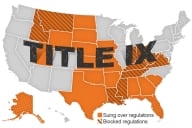You have /5 articles left.
Sign up for a free account or log in.
The latest white paper from a Bill & Melinda Gates Foundation-funded effort to rethink the nation’s financial aid system argues for a near-total overhaul -- shoring up the Pell Grant, reducing the amount many students and parents can borrow, and using federal aid to encourage colleges to better serve students from low-income backgrounds.
The paper from the New America Foundation, “Rebalancing Resources and Incentives in Federal Student Aid,” is one of several policy briefs recently released in the Gates effort to reimagine financial aid in the months (or, more realistically, years) that remain before Congress overhauls the Higher Education Act. It's intended to rethink the financial aid system within the existing budget constraints.
The proposal, which is designed to be implemented as a coherent whole, would keep the Pell Grant as the bedrock of financial aid to low-income students, and aims to strengthen its position at the heart of federal financial aid. The grant would be made an entitlement, no longer subject to annual appropriations -- long a goal of financial aid advocates. The maximum grant would increase faster than is currently planned. And the year-round Pell Grant, killed last year amid budget woes, would be restored. (The tens of billions of dollars to do all this would come from other changes in the plan -- more on that later.)
The Pell Grant would become part of a carrot-and-stick system, designed to change the incentives for colleges (but largely not imposing new requirements on students, as some have advocated). Four-year public and private nonprofit colleges with graduation rates over a certain percentage that enroll a large proportion of low-income students would receive additional federal money, as would community colleges with high graduation and transfer rates. Four-year colleges that enroll a low percentage of poor students, and charge them on average more than $10,000 a year after financial aid, would be required to match at least a portion of the Pell Grant money they receive with need-based aid from their own institutional funds.
The plan would make an exception for colleges whose endowments are too small to provide additional financial aid. The policy researchers emphasize that the provision is aimed at colleges that choose to spend their endowments on "merit based" financial aid aimed at attracting students with higher grades and test scores (and improving their rankings), rather than on helping low-income students.
In his State of the Union address a year ago, President Obama proposed using some of the government's financial aid funds to encourage colleges to hold down prices. But the New America proposal is unusual in planning to reward or punish colleges based solely on their low-income students, and in requiring colleges to pay up with their own money rather than punishing them by yanking federal dollars.
Besides the additional money, students would see one big change: they could receive Pell Grants only for five years for a four-year degree, or for two-and-a-half years for a two-year degree. (Time in remedial classes would not count toward the limit.) The limit is currently 12 semesters, or six years, whether at a two- or four-year college.
The changes would be paid for in part by eliminating all tax credits and deductions for higher education. (Other savings in the plan, which is intended to cost the government no additional money, would come from encouraging borrowers to consolidate old bank-based student loans into direct lending.) The plan would end the American Opportunity and Lifetime Learning tuition tax credits; tax-advantaged savings plans for education; and the student loan interest deduction.
The plan would also simplify the student loan system -- eliminating subsidized undergraduate loans, enrolling all borrowers automatically in income-based repayment and establishing an interest rate fixed for the life of the loan but that varies with the government’s cost of borrowing. Most significantly, it would cut deeply into the availability of government-issued student loans. The Grad PLUS program, which lets students borrow up to the cost of attendance for graduate school, would be eliminated, as would Parent PLUS loans, a similar program for parents of undergraduates. Borrowing limits would increase slightly, but undergraduates would be limited to $40,000 total, and graduate students to $25,500 per year.
The authors acknowledge that the change might drive more students to private loans -- which are not eligible for income-based repayment -- but say that it could help drive down the price of college, and particularly of graduate education, in the long run, by slowing the ready supply of government funds that can allow tuition levels to rise. For private loan borrowers, the report recommends allowing the discharge of private loans in bankruptcy.
Some of the ideas are considered unlikely or politically unfeasible: several of the deductions and tax credits that the report targets were recently extended by Congress in the year-end tax deal, for example. But the authors argue that the system needs to be implemented as a whole, rather than Congress cherry-picking specific cuts or expansions. “These proposals work best in combination,” they wrote. “They ask more of students and institutions, and provide more in return.”








